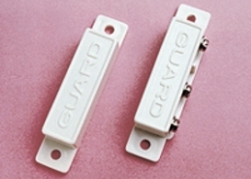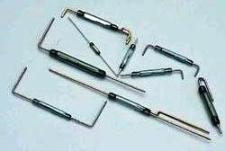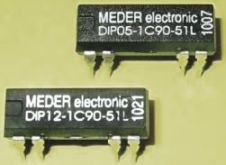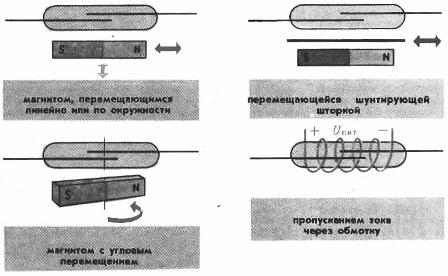Categories: Featured Articles » Novice electricians
Number of views: 91260
Comments on the article: 2
Reed switches: control methods, examples of use
The first part of the article: What are reed switches, how are they arranged and work?
 Reed switches have a number of mechanical and electrical parameters that characterize their properties. These parameters can be divided into two large groups: mechanical and electrical.
Reed switches have a number of mechanical and electrical parameters that characterize their properties. These parameters can be divided into two large groups: mechanical and electrical.
Mechanical parameters of reed switches
The mechanical parameters include magneto-driving force. This parameter shows at what value of the magnetic field the contact is released and released. In the technical documentation, this is referred to as the magnetomotive actuation force (denoted by Vav) and the magnetomotive releasing force (denoted by Votp).
The important parameters of the reed switch, in some cases the main ones, are speed of its operation and release. These parameters are usually measured in milliseconds and are designated respectively as tav and totp, which generally characterize the speed of the reed switch. Reed switches having a smaller geometric dimensions have a higher speed.
Maximum number of operations, or simply a resource, also belongs to the group of mechanical parameters. This parameter stipulates at what number of trips all the properties of the reed switch, both mechanical and electrical, are kept within acceptable values. In the technical documentation is designated as Nmax.
Electrical parameters of reed switches
 These parameters are the same as conventional mechanical contacts. The resistance measured between the closed contacts is called contact resistance and is designated as Rк, and the resistance measured between open contacts is nothing but the insulation resistance R from.
These parameters are the same as conventional mechanical contacts. The resistance measured between the closed contacts is called contact resistance and is designated as Rк, and the resistance measured between open contacts is nothing but the insulation resistance R from.
Reed electric strength. This parameter characterizes the breakdown voltage Upr. This voltage mainly determines the quality of insulation between the contacts, which in turn is determined by the quality of the vacuum or filling the flask with inert gases. In addition, the breakdown voltage depends on the size of the gap between the contacts and the quality of their coating.
Reed Switch Power It is determined mainly by its design: the material and size of the contacts, as well as the type of coating of the pads. In the technical documentation, this parameter is referred to as Pmax.
Capacitymeasured between open contacts is denoted as Ck. It depends only on the geometrical dimensions of the reed switch and the distance between open contacts.
Ways to manage reed switches
They can be divided into two large groups: permanent magnet control and control with a current coil. These methods are shown in Figure 1.
Figure 1. Various ways to control reed switches
Permanent magnet control of a reed switch
The most simple and common method of control with linear movement of the magnet. It is quite appropriate to recall here burglar alarmwhere the magnet is mounted on the door and makes the reed switch operate when the door is closed.
 The method with the angular movement of the magnet is used much less often, as a rule, in those cases when other methods are applied according tothEither reason is impossible.
The method with the angular movement of the magnet is used much less often, as a rule, in those cases when other methods are applied according tothEither reason is impossible.
Overlapping the magnetic field with a curtain was used in the keyboards of various computing devices, up to the nineties of the last century, and maybe it can be found somewhere until now.
Reed control with DC coil
This method was most common when creating reed relays. The design of these relays is quite simple: a reed switch is simply placed inside the current coil, and no additional springs and levers are required, like a conventional relay.The only drawback in this case is the small number of contact groups.
If the coil is made with a sufficiently thick wire capable of passing a large current, then a reed current relay can be obtained. Such relays were widely used in powerful DC sources as a sensor of an overload protection system. Precise adjustment of the level of operation of such a sensor is carried out by a threaded mechanism that allows you to smoothly move the reed switch along the axis of the coil.
Padvantages and disadvantages of reed switches
 Like any thing, reed switches have their advantages and disadvantages. First, let's talk, of course, about the benefits.
Like any thing, reed switches have their advantages and disadvantages. First, let's talk, of course, about the benefits.
Compared to conventional switching contacts, reed switches are almost 100 times more reliable than conventional open contacts. This reliability is due to higher insulation resistance (reaches tens of MegaOhm), and greater electrical strength: breakdown voltage for some types of reed switches reaches several tens of kilovolts.
The indisputable advantage of reed switches is their speed: for some models of reed switches, the switching frequency reaches 1000 Hz, and the response and release speed is in the range (0.5 - 2.0ms) And (0.2 - 1.0ms), respectively.
The service life of some reed switches reaches 4–5 billion operations, which is much higher than that for conventional unprotected contacts. Also, the advantages of reed switches include an easy way to match the load, as well as the operation of reed switches without the use of electric energy sources.
Reed Switches
Against the background of advantages, the disadvantages are probably not so great. Firstly, this is a small switched power. In addition, a small number of contact groups in one cylinder and for “dry” reed switches contact bounce. The disadvantages include the fragility of the glass bottle and, in some cases, high sensitivity to external magnetic fields.
Boris Aladyshkin
See also at bgv.electricianexp.com
:

